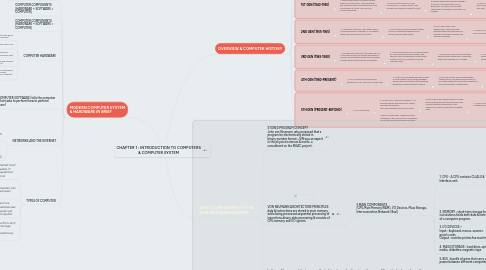
1. MODERN COMPUTER SYSTEM & HARDWARE IN BRIEF
1.1. WHAT IS A COMPUTER? computer is an electronic device for storing & processing data,in binary form,according to instructions given to it in a variable program.
1.2. COMPUTER COMPONENTS [HARDWARE + SOFTWARE = COMPUTER]
1.3. COMPUTER COMPONENTS [HARDWARE + SOFTWARE = COMPUTER]
1.4. COMPUTER HARDWARE
1.4.1. 1. INPUT DEVICE (to enter data & instruction into a computer)
1.4.2. 2. OUTPUT DEVICE (conveys info to one more people)
1.4.3. 3. SYSTEM UNIT (contains electronic components that are used to process data)
1.4.4. 4. STORAGE DEVICE (records and retrieves items to & from storage media)
1.4.5. 5. COMMUNICATION DEVICE (enables a computer to send & receive data, instructions and info to more computer/ mobile devices)
1.5. COMPUTER SOFTWARE (tells the computer what tasks to perform/how to perform them)
1.5.1. SYSTEM SOFTWARE (operating system & utility program) -provide a platform for other software
1.5.2. APPLICATION SOFTWARE (general-purposed,specialized & apps) -end user software,program that performs a common task to the user
1.6. NETWORKS AND THE INTERNET
1.6.1. Network (a collection of computers & devices connected together,via communication devices and transmission media)
1.6.2. Internet (a worldwide collections of networks that connects millions of businesses,government agencies, educational institutions, and individuals)
1.7. TYPES OF COMPUTER
1.7.1. SUPERCOMPUTERS (the fastest,most powerful computer) are capable of processing more than one quadrillion instructions in a single second.
1.7.2. MAINFRAME COMPUTERS (large,expensive,powerful computer) can handle 100-1000 of connected users simultaneously.
1.7.3. MIDRANGE COMPUTERS (servers) are computers with processing capabilities less powerful than a mainframe computer yet more powerful than a personal computer.
1.7.4. PERSONAL COMPUTERS can perform all of its input,processing,output, and storage activities by itself. (ex:desktops,laptops,tablets,smartphones, and wearables)
2. OVERVIEW & COMPUTER HISTORY
2.1. 0TH GEN (1642-1940)
2.1.1. 1. BLAISE PASCAL designed first calculator that performed "+" and "-".
2.1.1.1. 2. GOTTFRIED built the first calculator to do "*" and "/". (Stepped Reckoner)
2.1.1.1.1. 3. CHARLES BABBAGE "Analytical Engine" had 4 components-memory,computation unit,punched card reader,& punched and printed outputs.
2.2. 1ST GEN (1940-1955)
2.2.1. 1. The first generation computers usually took up an entire room. They were large and limited to basic calculations,only solve one problem at a time. Use VACUUM TUBES technology.
2.2.1.1. 2. INVENTOR/INVENTION John W.Mauchly & J. Presper Eckert. First all-electronic digital computer (ENIAC).
2.2.1.1.1. 3. MAIN FEATURES vacuum tube techno, unreliable,supported machine language only,very costly,generated a lot of heat,input : punched cards & paper tape,output : displayed on printouts. AC needed.
2.3. 2ND GEN (1955-1965)
2.3.1. 1. A transistor computer, now often called a second generation computer, is a computer which uses discrete TRANSISTORS.
2.3.1.1. 2. INVENTION made of specially treated silicon,use assembly language,more energy-efficient than before
2.3.1.1.1. 3. MAIN FEATURES more reliable,more compact,smaller size,generated less heat,faster,AC needed & supported machine and assembly language.
2.4. 3RD GEN (1965-1980)
2.4.1. 1. INTEGRATED CIRCUITS (IC) based. An IC is a small device that can contain thousands of devices like transistors,resistances, and other circuit elements that make up a computer.
2.4.1.1. 2. INVENTOR/INVENTION IC was invented by Jack Kilby. Remote processing, time- sharing, multi-programming os were used. ROBERT NOYCE & GORDON MOORE founded INTEL.
2.4.1.1.1. 3. MAIN FEATURES more reliable than before,lesser maintenance, supported high-level language & AC needed.
2.5. 4TH GEN (1980-PRESENT)
2.5.1. 1.VLSI MICROPROCESSOR based. thousands of ICs built onto a single chip.
2.5.1.1. 2. INVENTION computer become smaller & more powerful.GUIs,mouse,handheld devices,open architecture (the hardware design was made available to anyone.
2.5.1.1.1. 3. MAIN FEATURES very cheap,portable ,reliable,use of PCs,pipeline processing, no AC needed,internet concept was introduced, great development of networking.
2.6. 5TH GEN (PRESENT-BEYOND)
2.6.1. 1. ULSI Technology .
2.6.1.1. 2. INVENTION >Artificial Intelligence : to develop devices that respond to natural language input,able to learn,self-organize,robotics,nano-tech.
2.6.1.1.1. 3. MAIN FEATURES advancement in parallel processing,superconductor tech,more user friendly interfaces,availability of very powerful & compact computers at cheaper rates.
2.6.1.2. >Age of Connectivity : release of WWW standards in 1991,connect to all computers all over the world,and wireless revolution.
3. BASIC COMPONENTS OF THE VON NEUMANN MACHINE
3.1. STORED PROGRAM CONCEPT John von Neumann, who proposed that a program be electronically stored in binary-number format. JVN was an expert in the physical sciences & maths, a consultannt on the ENIAC project.
3.2. VON NEUMANN ARCHITECTURE PRINCIPLES data & instructions are stored in main memory while being processed,sequential processing of insructions,binary data processing & consists of CPU,memory and I/O system.
3.2.1. 5 MAIN COMPONENTS [CPU,Main Memory(RAM), I/O Devices, Mass Storage, Interconnection Network (Bus)]
3.2.1.1. 1. CPU - A CPU contains CU,ALU & Interface unit.
3.2.1.1.1. -ALU : arithmetic/logic unit performs arithmetic & Boolean logical calculations.
3.2.1.1.2. -CU : control unit controls instruction process & movement of data within the CPU.
3.2.1.1.3. -Interface unit : moves data & instruction between the CPU and other components. (Bus : bundle of wires that carry signals and power between different components).
3.2.1.2. 2. MEMORY : short-term storage for CPU calculations,holds both data & instruction of a computer program.
3.2.1.3. 3. I/O DEVICES :- Input : keyboard, mouse, scanner, punch cards. Output : monitor,printer,fax machine.
3.2.1.4. 4. MASS STORAGE : hard drive, optical media, diskettes, magnetic tape
3.2.1.5. 5. BUS : bundle of wires that carry signals & power between different components.
